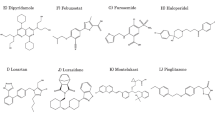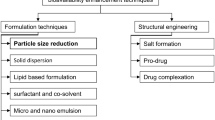Abstract
The dissolution rates of two lots of hydrocortisone (fine and coarse) were simulated using a computer program based on a Noyes–Whitney-type equation. Derivations of the equation were made to compare the accuracy of simulations using spherical and cylindrical particle geometry, with and without a time-dependent diffusion layer thickness. To approximate better the shape of the hydrocortisone particles, a shape factor was used to relate cylindrical length to radius. The most accurate simulations were obtained by assuming cylindrical geometry with and without a time-dependent diffusion layer thickness for the fine and coarse hydrocortisone, respectively. The program was also modified to simulate initial particle size distributions based on the log normal probability density function.
Similar content being viewed by others
REFERENCES
J. B. Dressman and D. Fleisher. Mixing-tank model for predicting dissolution rate control of oral absorption. J. Pharm. Sci. 75:109–116 (1986).
R. J. Hintz and K. C. Johnson. The effect of particle size distribution on dissolution rate and oral absorption. Int. J. Pharm. 51:9–17 (1989).
A. A. Noyes and W. R. Whitney. The rate of solution of solid substances in their own solutions. J. Am. Chem. Soc. 19:930–934 (1897).
W. I. Higuchi and E. N. Hiestand. Dissolution rates of finely divided drug powders I. Effect of a distribution of particle sizes in a diffusion-controlled process. J. Pharm. Sci. 52:67–71 (1963).
S. E. LeBlanc and H. S. Fogler. Population balance modeling of the dissolution of polydisperse solids: Rate limiting regimes. AIChE J. 33:54–63 (1987).
T. Allen. Particle Size Measurement, 3rd ed., Chapman and Hall, New York, 1981.
J. D. Stockham and E. G. Fochtman. Particle Size Analysis, Ann Arbor Science, Ann Arbor, MI, 1978.
J. T. Carstensen and M. N. Musa. Dissolution rate patterns of log normally distributed powders. J. Pharm. Sci. 61:223–227 (1972).
D. Brooke. Dissolution profile of log-normal powders: Exact expression. J. Pharm. Sci. 62:795–798 (1973).
Y. Yonezawa, I. Shinohara, A. Otsuka, and H. Sunada. Changes of surface area in the dissolution process of crystalline substances. V. Dissolution and simulation curves for log-normal particle-size distributed model systems. Chem. Pharm. Bull. 38:1024–1026 (1990).
K. Diem and C. Lenter. Scientific Tables, GEIGY Pharmaceuticals, New York, 1970.
R. C. Reid, J. M. Prausnitz, and T. K. Sherwood. The Properties of Gases and Liquids, McGraw-Hill, New York, 1977.
P. Harriott. Mass transfer to particles. I. Suspended in agitated tanks. AIChE J 8:93–101 (1962).
M. Bisrat, E. K. Anderberg, M. I. Barnett, and C. Nyström. Physicochemical aspects of drug release. XV. Investigation of diffusional transport in dissolution of suspended, sparingly soluble drugs. Int. J. Pharm. 80:191–201 (1992).
J. Mauger and S. Howard. Model systems for dissolution of finely divided (multisized) drug powders. J. Pharm. Sci. 65:1042–1045 (1976).
H. N. Rosen and H. M. Hulbert. Size analysis of irregular shaped particles in sieving. Comparison with the Coulter counter. Ind. Eng. Chem. Fund. 9:658–661 (1970).
P. J. Lloyd. Response of the electrical sensing zone method to nonspherical particles. In N. G. Stanley-Wood and T. Allen (eds.), Particle Size Analysis 1981, Wiley Heyden Ltd., London, 1981.
R. K. Eckhoff. Experimental indication of the volume proportional response of the Coulter counter for irregularly shaped particles. J. Sci. Instrum. 44:648–649 (1967).
Coulter Electronics. Coulter Counter Model TA Instruction and Service Manual, Hialeah, FL, 1972.
Author information
Authors and Affiliations
Rights and permissions
About this article
Cite this article
Lu, A.T.K., Frisella, M.E. & Johnson, K.C. Dissolution Modeling: Factors Affecting the Dissolution Rates of Polydisperse Powders. Pharm Res 10, 1308–1314 (1993). https://doi.org/10.1023/A:1018917729477
Issue Date:
DOI: https://doi.org/10.1023/A:1018917729477




